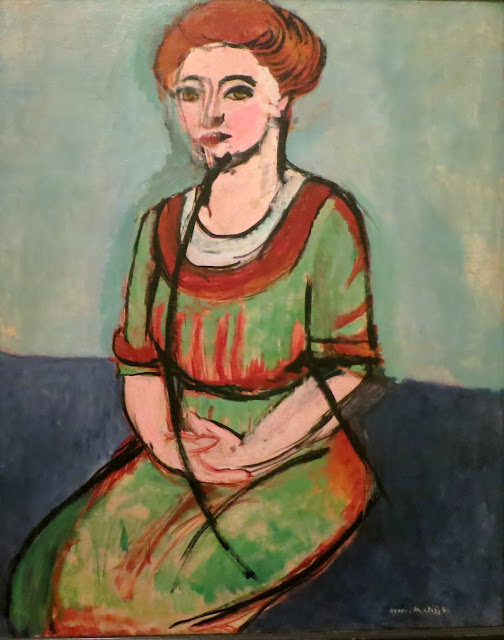Matisse in the Studio, at the Royal Academy of Arts, London.
Matisse once stated: 'The object is an actor. A good actor can have a part in ten different plays; an object can play a role in ten different pictures'. Matisse loved, and collected objects: furniture, textiles, sculptures, vases, jugs, African masks. His engagement with African sculpture marks a turning point in modern art. The disregard for accurate physical form in African art had a significant impact on Matisse's own sculpture in the early years of his career. African masks also made a particularly strong impact on his portraiture - the abstract simplification and forceful geometric designs helped Matisse to go beyond straightforward resemblance towards portraits that, as he explained, 'suggest the deep gravity that persists in every human being'.
This exhibition presents works by the artist in the company of objects from his collection. I was particularly taken with his collection of African masks, but as photography is not allowed in the exhibition, I am unable to show some of those.
Embroidered Textile Maquette for Red Chasuble, 1912
Panel with Mask, 1947
Quite a few of Matisse's cut-outs are displayed, most of which were completed in the 14-year period after his near-fatal operation for stomach cancer. You can see more of these here and here
Discussing the cut-outs in 1951, Matisse said: 'I have attained a form filtered to its essential... and of the object which I used to present in the complexity of its space, I have preserved the sign, which suffices'.
Odalisque on Turkish Chair, 1928
Matisse's densely patterned interiors challenged the convention that the human figure should be the focus of the artwork. In this painting of a reclining female model, he gave equal weight to the objects, the surrounding decoration and the woman herself. Connections are made between the pattern of the blue and the white vase and the model's ornate clothing, and between the chessboard and the beads around her ankle. By diminishing the importance of the model (see, for example, her simplified facial features and vacant expression) Matisse defies centuries of Western art, in which the reclining nude was an object of desire. It was the visual stimulus of Islamic culture that appealed to him: 'For me, the subject of a picture and its background have the same value... there is no principal feature, only the pattern is important'.
Margueritte with Black Velvet Ribbon, 1916
Portraiture for Matisse was about far more than representing features accurately. He sought to evoke enduring qualities beyond likeness: his subjects' true identities, their significance to him, and the experience of their sessions in the studio. From about 1906, Matisse's portraiture incorporated the lessons that he had learned from the sculpted heads and masks in his collection, although some items seem to have caught his eye because they echoed directions that he was already taking in his art.
Marguerite, 1906-07
Portrait of Olga Merson, 1911
Yellow Odalisque








No comments:
Post a Comment